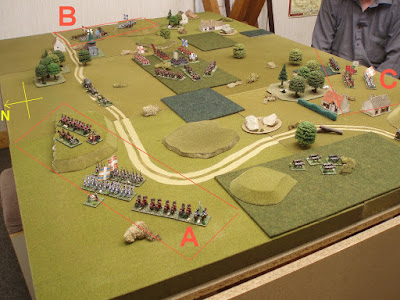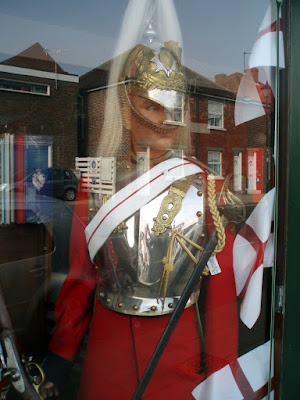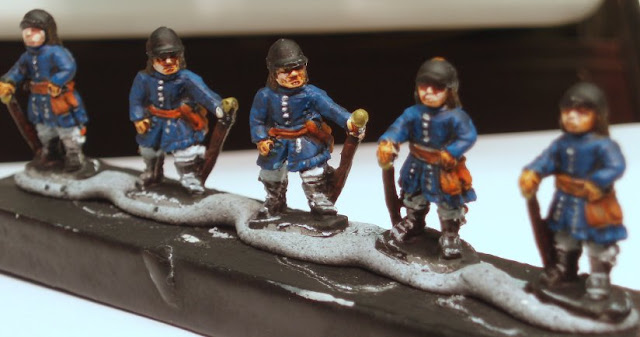With DG's recent visit to these parts (to attend Salute) it seemed more than sensible that he and I get together for a game - his visits are few and far between so all opportunities should be exploited to the maximum...
So it was that on the evening of the 27th he and I met over the field of battle to have a go at the "Encirclement", or "Breakout" scenario from the Grant and Asquith "Scenario's for all Ages" book..
We hadn't played a War of the Spanish Succession game for some time, and having recently completed the Agenois and Howe's regiments (and wanting an opportunity for them to march to their first glorious encounter!) we swiftly agreed that Marlburian period it should be..
ScenarioBriefly the scenario posits the position that one sides army (in this case the Allies) has advanced too far into enemy territory in pursuit of a numerically smaller enemy force (in this case the French).. at the point where they realise they have advanced too far they are then surrounded by an additional two other smaller French forces that,
when combined, significantly outnumber them.
It was agreed that I would command the French and DG the Allies.
The Allied mission is to breakout and exit from one edge of the table without losing a significant part of their force.. a win is therefore dependant on them losing less than a specific percentage of the force, while a draw is a higher percentage, and a loss is an even higher percentage.. I won't go into details as you really need to buy the book which deserves a place on any thinking gamer’s bookshelf!
So in the following you see the table layout, and the position of the three French forces and the Allied force...

It's clear then that the force breaking out needs to chose the direction they do this in carefully, so in order to give DG some time to think I had already deployed the French forces allowing the British to react to this by setting up second.
Another view of the starting positions - this time showing force designations:
 The Game
The GameDG decided that he was going to break out in the direction of the church and I for one thought his plan to enable this was quite sound - he left his cavalry and artillery to cover the withdrawal and set his infantry off immediately in the direction of my much smaller blocking force "B" (this comprised three regiments of foot, one of which was the Agenois regiment, and an artillery piece).
While he did this I started moving my cavalry in force A & C and the artillery from force A forward (both sides were allowed only light pieces with limited range) ready to launch my first attacks on DG's cavalry blocking force.
The cavalry attack by force A proved disastrous as extremely poor morale and a lack of moral fibre (ie. a 1 on the dice!) resulted in the first unit leaving the table.. if they had any battle honours to strip I would have taken them!
 In this picture DG's foot are hot footing towards their date with destiny... well, the Agenois Regiment anyway!
In this picture DG's foot are hot footing towards their date with destiny... well, the Agenois Regiment anyway!The artillery however opened fire, and the first casualties began to appear in the ranks of DG's cavalry..
In the face of a gradual advance by the infantry from forces A & B his cavalry started to pull back slowly...
At the other end of the table however his infantry had finally reached the church and started to deploy from column of march to line... despite, or perhaps because of, the urgency of the situation the 1st Foot Guards failed to complete the evolution - difficult to believe, but in the heat of the moment even Queen Anne's finest sometimes miss their step. Sensing a huge opportunity the colonel of the Agenois Regiment charged his men forward on their disorganised ranks. The Guards throw to see if they stand the charge - despite the negatives for their disorganised state they stand!! I can see DG chuckling even now... We agree that it makes little sense that they be allowed to counter charge, so move to the melee - we throw the dice - I score low, DG scores high, and the Agenois regiment are sent packing in huge disarray (rout and lose 2 strength points from their complement of 5). Quelle domage....!
In the ensuing morale checks they fail again and the
second French regiment leaves the table...
I would say that this was the nadir of the French fortunes - two regiments gone, can't get past his cavalry, and four of his foot regiments bearing down on two of mine - one of whom (the Royal Italien) are in total disarray having failed to complete the deployment from column to line .... it was not over yet, however...

At the other end of the table I had managed to pin one of DG's cavalry regiments with my Irish foot (Lee's - see the picture just above) while getting the cavalry away to advance east. In the next picture you can see them just passing the building and broken ground in the far right distance...

Melee's at this end of the table saw at least one of the British cavalry units break, but the main damage was done by the recovered Royal Italien, and the attached gun - in one move both units managed double six score's on the Guards causing massive casualties, that in the end signified my victory conditions had been met.
Post match analysis:- I think it very unlikely that DG and I will ever have another game where the disparity in dice rolls was quite as marked as it was in this game. 1's, 2's or 5's & 6's were the mark of the evening - even when using double dice. On the plus side I think we'd agree that there was an equal disparity on both sides - sometimes I was lucky (the shooting on the Foot Guards) sometimes DG was (Agenois foot, and Chartres cavalry, routing)
- I think the key to this scenario is the artillery because of it's ability to inflict damage (ie. win points towards your victory total) at a distance - initially both I, and I think DG, thought it might be the cavalry that were the winning edge because of the distance they can move. If we were to play this again then, I think my decision would be tempered by this - in this case the obvious soft spot is the French "C" force. Isn't hindsight a wonderful thing!?
- We did have a couple of interesting melee's where units managed to contact flank and rear, but the rules (we used my variant of Will McNally's SYW rules) are flexible enough that we managed to work through these and iron out any inconsistencies. I almost had another disaster when charging into the flank of one of DG's cavalry regiments only for them to stand and fight back - oh no I thought - "I've been here before". Luckily (for that is what it sometimes is) I prevailed... So in summary, no rules updates required, though I may need to make some modifications to the formations allowed for western European units as DG had one of his infantry units wandering around in a block of four for some time...!
- Other than that this was a nice straight forward game - it didn't take long - a couple of hours maximum but that was no bad thing as were going to Salute the next day and had an early start..
 Just finished the latest offering from Iain Gale in the "Jack Steel" series - this is number 3, and deals with the Oudenarde campaign and its aftermath...
Just finished the latest offering from Iain Gale in the "Jack Steel" series - this is number 3, and deals with the Oudenarde campaign and its aftermath...























